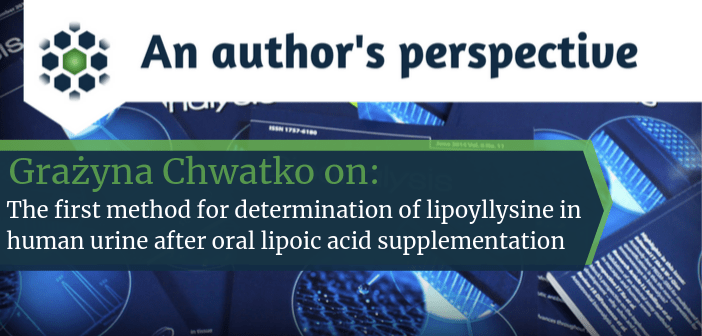An author’s perspective: Grażyna Chwatko on the first method for determination of lipoyllysine in human urine

To help provide insight into the recent article published in Bioanalysis: The first method for determination of lipoyllysine in human urine after oral lipoic acid supplementation, we spoke with author Grażyna Chwatko, Associate Professor at the University of Lodz (Łódź, Poland). Grażyna discusses her inspiration and why she feels this is an important area for bioanalysis.
“I graduated from the University of Lodz (Poland), Faculty of Physics and Chemistry, with a degree in analytical chemistry. I received my PhD degree in 2002 from the Department of Environmental Chemistry of the University of Lodz, for a dissertation based on the estimation of plasma thiol redox status in human plasma by high performance liquid chromatography. In 2003, I began a 1-year postdoctoral fellowship at the International Center for Public Health in the New Jersey Medical School (NJ, USA). I am currently an Associate Professor at the Department of Environmental Chemistry, Faculty of Chemistry, University of Lodz. My current research interests include developing new methods for tracking sulfur compounds in biological samples by means of separation techniques.”
1. What inspired you to work in this field of bioanalysis?
I have been tracking metabolically related sulfur compounds such as homocysteine, cysteine, glutathione and cysteinylglycine in biological samples for many years. These compounds are associated with many lifestyle diseases accompanied by oxidative stress. Lipoic acid is a direct and indirect antioxidant used both in the prevention and treatment of diseases related to oxidative stress. In the literature, much attention has been paid to lipoic acid while there is little information about its lysine conjugate, named lipoyllysine. The lack of information on the occurrence of lipoyllysine in human bio fluids inspired us to work in this field.
2. What impact would you like to see/expect to see as a result of your publication?
I believe that the proposed first method for estimating lipoyllysine and lipoic acid levels in urine may be helpful in studies dealing with the role of lipoic acid, or in studies of the possible role it plays in various diseases, such as cardiovascular, diabetes, neurodegenerative and liver disorders. Thus, the method seems to be suitable for researchers involved in these kinds of studies.
Click here to read the article in Bioanalysis
3. What are the next steps for your research and this field of bioanalysis?
New, reliable, accurate and precise analytical methods are needed to track the metabolic changes of important chemical compounds. Therefore, my work will include providing new research tools to track potential drug metabolites or markers of lifestyle diseases.
4. Are there any researchers/projects/technologies that you are watching at the moment, and any you think we should be keeping an eye on?
Biological samples are one of the most complex matrices, so sample preparation is a crucial step to glean reliable results. The techniques used for the analysis of biological samples do not allow the determination of trace components in the sample without its appropriate pretreatment, so new techniques in this field are worth tracking. Nowadays, micro-extraction and the use of nanomaterials in extraction are dynamically developing techniques.
5. Do you have any advice for anyone who may be interested in working in this field?
Be an active part of the research team, critically evaluate your results and don’t hesitate to ask difficult questions.
Click here to read the article in Bioanalysis
Click here for more ‘An author’s perspective’ interviews
Reference: Chwatko G, Kamińska A, Głowacka IE et al. The first method for determination of lipoyllysine in human urine after oral lipoic acid supplementation. Bioanalysis. 11(14): 1359–1373 (2019)
Disclaimer
The opinions expressed in this interview are those of the interviewee and do not necessarily reflect the views of Bioanalysis Zone or Future Science Group.






